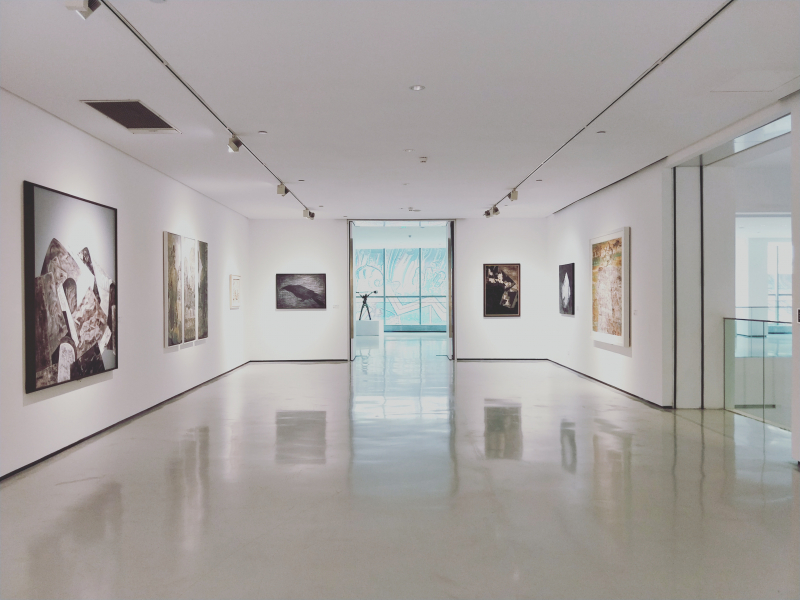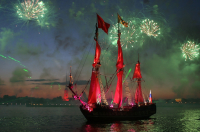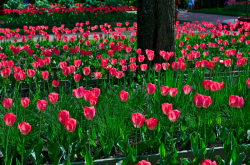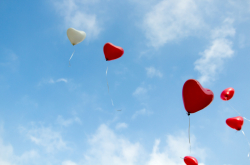This exhibition — entitled Knight of Despair / Warrior of Beauty — is designed specifically for people who have *never* heard of Fabre, who have instead come to the Hermitage to witness the magnificence of the Malachite Room, or the shimmering visual wizardry of the golden Peacock Clock, or just to marvel at the old masters in the museum’s regular collection.
For these visitors, the shock and awe of stumbling upon Fabre’s eerie dancing skeletons, baying hounds of hell and monstrous three dimensional dinosaur fossils, all created from the shimmering dark blue-green exoskeletal shells of beetles, is simultaneously jarring, engrossing and disquieting.
Even more baffling is the fact that all this is happening in the Hermitage, the hallowed inner sanctum of Imperial pomp and high-classicism. To exacerbate the reaction, Fabre has pitted himself in particular against the nigh-unassailable Dutch and Flemish Masters, brazenly and provocatively staring down such figures as Brueghel, Rubens, Van Dyck.
No matter what you ultimately think of it — and reactions so far have ranged indignation to pure, online spleen at what many have considered particularly extreme and cruel aspects — this is unquestionably one of the most challenging exhibitions to be seen in Russia this year.
But before we deal with that, first a little introduction to the interdisciplinary magic and extravagant obsessions of Mr. Jan Fabre.
To explain his insect fixation, he has often claimed — apocryphally or not — that he is related to his namesake, the 19th Century French entomologist Jean-Henri Fabre, who wrote a 10 volume authoritative treatise on the subject.
What is known for certain is that Fabre was born in 1958 in a poor, down-at-heel district of Antwerp into a rather unremarkable family. Inspired by Rubens, he enrolled at the Antwerp Academy of Beaux Art and was soon already developing some of the techniques that would establish his artistic career. These included his so-called Bic-Art, works created entirely from dense patterns of scribbles made with a ballpoint pen (examples of which are included in the current Hermitage exhibition) as well as gory cartoonish vignettes painted using smears and splodges of his own blood, and of course the beetle paintings. His 2002 work "Heaven of Delight' covered the ceiling of the Royal Palace in Brussels with a mind-boggling 1.6 million iridescent green jewel-scarab wing cases.
In the late 1970s, Fabre branched out into performance with a piece entitled His Money, during which he incinerated bundles of cash and created artworks out of the ashes. In 1982, he unleashed The Power of Theatrical Madness, which involved full-frontal nude dance routines, a plague of live frogs and a symphony of smashing crockery.
Last summer, Fabre attracted global headlines by attempting to transform the sacred institution of the Epidaurus Festival, normally an ultra-conservative showcase of Greek Tragedy into a "celebration of Belgium', replacing 8 of the 10 productions with contemporary Belgian shows! He resigned as artistic director in the face of unprecedented Greek uproar!
It was against this backdrop of scandal that Hermitage director, Mikhail Piotrovsky made the brave — some might say, reckless — decision to throw open the doors of the museum to Mr. Fabre, giving him free reign to use some of the most cherished gallery rooms and priceless historical works as a playground for his upstart, insouciant imagination.
Naturally, there has been the inevitable critical and populist backlash. An internet campaign has been set up with the aim of shutting down the exhibition and firing Piotrovsky, with daily bile spilling onto the internet via the hashtag #pozorermitazhu ("shame on the Hermitage"). The works have been labelled "an abomination.' As a result of accompanying exhibits in the adjacent General Staff building depicting stuffed cats and dogs hanging from hooks, Fabre has been labeled a "tramp" and a "pelt-skinner."
Fabre himself thrives on just this kind of controversy. He’s been honing and tooling it all of his professional life. But the exhibition he has created here is a much more subtle and powerful and — towards the end — transcendental experience than this tawdry twitter-fueled media firestorm would imply.
It all begins rather conventionally in the Museum’s Apollo Room, where the original Dutch carvings have now been joined by a selection of intriguing Fabre works, including "I Let Myself Drain,' a "surrealist self-portrait' in which a life-sized wax figure stands with its face pressed against a copy of the famous 15th century Roger van der Weyden "Portrait of a Man'; "Holy Dung Beetle,' in which an oversized gilt scarab has been impaled with a cross: as well as various golden trinkets — parrots, lizards, owls, walking sticks. Overall, this first room serves as Fabre 101, a light and breezy crash-course in his work.
Then Fabre takes us down two long corridors where Grand Flemish Masters — from Jan Brueghel the Elder to Rogier van der Weyden to Lucas van Leyden — are interspersed with his own miniature, cartoonish — and let’s face it, rather poor — peasant drawings. To make matters even more twee, the drawings in the second room are all on the cutesy, gif-attachment subject of cats.
Between Fabre and the Masters, there is of course "no comparison', and we find ourselves muttering the words "no comparison' - continually! — but this is just Fabre the showman toying with us, lulling us into a false sense of haughty security.
The rationale behind Fabre’s approach only becomes devastatingly apparent when we reach the Jordaens Gallery, which Fabre has packed with his dung beetle depictions of jiggling skeletons, grandfather clocks, biker skulls, dobermans, horrifically outsized flies and in the centre, a terrifying sculpture of a skeletal hound with a multicoloured tropical bird clenched between its jaws. For the first time, this is a room where regular gallery-goers and Farbre enthusiasts meet and mingle, and there is a genuine sense of a developing narrative, like a dive-bar before the brawl or the stadium stands before a football cup-tie.
The invading Farbre works brutally and viciously rip attention away from the rightful inhabitants of this room: Jacob Jordaens, Brueghel, Cornelis De Vos. But at the same time, they paradoxically focus attention on the Old Masters. I have passed through these rooms many times but have never before looked with such intensity at Jordaens’s "Banquet of Cleopatra,' with its comic panache of caricatured courtiers, or Breughel’s "Forest's Edge' with its ominous glacial gathering clouds or De Vos’s Self Portrait with Wife Susan Koch, where the division between childish glee and adult posturing is so beautifully drawn. Farbre’s aggressive act of aesthetic vandalism has jolted these moribund paintings back to life.
The same is true in the next room — the Rubens Gallery — where Fabre has insinuated his forbidding Bic paintings. Overall, I spent exponentially less time looking at these giant hazy blocks of almost opaque ink than at "Bacchus', Rubens’s deliciously corpulent portrait of inebriation and decadence. In the Van Dyck Gallery, Fabre’s interjections have a little more substance — marble monuments to regular 21st Century residents of Antwerp and the artist’s various female friends, all ironically given noble titles. But still my eye was drawn to true nobility in the form of Van Dyck’s majestic portrait of Queen Henrietta-Maria, staring down sternly at the pale interlopers.
However, the true, inexorable denouement of Jan Fabre’s devilish strategy is still to come, in the next room — the Snyders Gallery. The 17th Century flemish painter is known for his visceral, almost super-realistic portrayals of hunting and market scenes — still lifes where the emphasis is emphatically on murder, carnage and the cleaving of flesh. As Farbre noted, the works "give off the sickly odour of slaughter, decay and death.'
The room has always been a powerful sensory onslaught, but now interspersed with Farbre’s grotesque and terrifying menagerie, it is almost unbearable. Between the grisly slasher glory of Snyders’s Fowl Market and Cook at a Kitchen Table with Dead Game, Fabre has inserted skulls with wild-fowl or rabbits hanging limply from their jaws. In the centre of the room is a beetle-encrusted ribcage with a peacock perched on top like a vulture, as well as strange skeletal ogre wrestling a swan to the ground. The overall effect is to add a daunting, bracing third dimension to the paintings, as if Fabre has issued every gallerygoer with a pair of polarized glasses. No-one who experienced the Snyders Gallery in this heightened, Fabrized incarnation will ever quite be able to strip away that exhilarating extra dimension. The imaginative transformation is permanent. It’s a monumental achievement.
The final few rooms of the exhibition are engaging enough — an array of gilded serf-portrait busts, with antlers, cow heads and horns of unicorns, as well as a mesmerizing dress in beetle shells. But without the clashing historical contrasts, it all suddenly feels very self-indulgent.
Just like the complementary sister exhibition in the General Staff Building, which features those dead pets that offended so many, showcasing Fabre’s work simply on its own merits serves only to expose his limitations. Put simply, Jan Fabre is not a great artist in the traditional sense. The works themselves can be silly and cartoonish — as if lifted from some naff and trashy Horror B-Movie or just downright nonsensical, like the Ballpoint portraits.
But — drawing on his startling stage productions — Fabre is a brilliant showman, a theatrical genius who has a deep understanding of the interconnecting strands, narratives, trajectories of art history and can play them like a virtuoso. Every single work in this exhibition is calibrated not to generate beauty for its own sake, but to achieve a desired effect on the viewer.
He also knows how to work the inevitable shock and outrage as exquisitely as any brush-strokes or bronze or clay. He brilliantly controls how these volatile quantities can manipulate audiences, heighten expectations, add allure, irradiate the artworks with an ethereal glow. He knows how affront begets PR, builds narratives, sends news stories flitting around the world. Most importantly, shock has the power to mythologize: "Once you indulge in a proper analysis to the word "provocation,'' he once said, "you will see that it means an evolution of consciousness.'
And it is for this precise reason that Knight of Despair / Warrior of Beauty just has to be seen. Experiencing it is an evolution. You will emerge with an altered consciousness. You will arrive energized at the end, no matter if that energy is buoyed by anger, outrage, frustration or amazement. It absolutely doesn’t matter. Just surrender yourself to Fabre, the master provocateur.
The exhibition will be running until the end of April 2017 at the Hermitage. Read more about it here.




